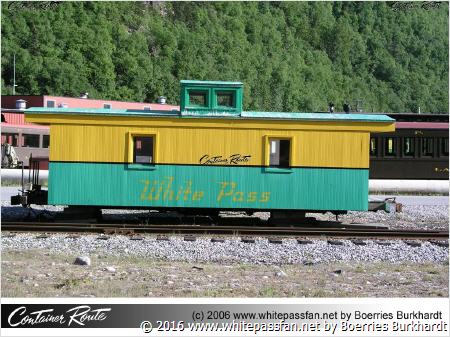911
Wold War II Vet Recalled To Active Duty
Former World War II Army Caboose 911, has been recalled from semiretirement to active duty to meet the demands of the increased freight service to the expanding Yukon.
In 1943 this caboose was rebuilt from a Colorado & Southern box car for the U.S. Army, who leased the White Pass & Yukon Route during World War II. It served in the Military Rail Service 770th Railway Operating Battalion's northern campaign, constructing the Alaska Highway, Whitehorse Air Base and several air fields along the Highway. Also involved in the wartime buildup was the Canol Project, which involved development of oil wells at Norma Wells, N.W.T., a crude oil pipeline to Whitehorse where a complete oil refinery had been transferred from Corpus Christi, Texas, and subsequent pipelines to Fairbanks, Skagway and Watson. 37 Trains in One Day
During this period, trains were run around the clock hauling thousand of tons of war material, 14 northbound trains and 23 southbound trains operated. On August 4th, 1943, a record of 2085 net tons were hauled over the grueling White Pass Summit to Whitehorse.
By the end of 1944 the invasion threat had been successfully combated. The Army gradually pulled out of Skagway, returning the operation of the railroad to civilian control. At the end of the War, the White Pass purchased much of the railway equipment and locomotives, including Caboose No. 911. The caboose lay in the Skagway yards until 1955 when it resurrected as a bunk car for the maintenance of way forces.
By 1967, increased traffic demands required additional freight trains, so the veteran caboose was brought back to Skagway for reconversion to a caboose again. Completing the conversion, the old box car red color scheme was changed to the modern high-visibility White Pass green and yellow.
Text from the Container Route News, March 1968
911

911 Caboose at Skagway (2005)
Rebuilt by the United States Army, a former C&S box car was rebuilt into a caboose.
TRAIL OF '98 CITY MUSEUM by Carl Mulvihill
Originally build in 1903 by the Colorado & Southern Railway as a composite type box car, it had a steel underframe, wood carbody and double sheathed wooden roof. It was 30'4" long, with a width of 93-1/2". The box car was converted to a caboose in 1943 fo r the U.S. Army 770th Operating Battalion. The White Pass & Yukon Route leased by the U.S. Army in World War II, was operated by the 770th who brought the caboose to Skagway.
Painted olive drab, the caboose, U.S.A. 90861, trailed the round - the - clock rush of freight trains, which often totaled as many as 37 trains per day over the railroad. These trains, vital to the war effort, hauled heavy duty equipment, supplies, troops and civilian contractors for the construction of the Alaska Highway, mil itary lend - lease airfields and oil field production installation and a complete petroleum refinery as well as miles of pipeline.
When the war was over and the Army terminated its lease, the White Pass purchased much of the surplus military railroad rolli ng stock. Slower postwar freight activity caused the caboose to placed in storage. In 1955 during an extensive rehabilitation of the narrow gauge railroad, the old caboose was returned to service. It was painted "boxcar red" and convert to a Bunk and Office Car. Number X-14 for the "Steel Gang" foreman. Increased traffic demands by 1967 required the car to be recalled to active service and reconverted as Caboose X-14. When the traffic rush slowed in the winter the caboose was extensively refitted, and when it rejoined the train service, it spotted the current bright yellow and green color scheme. The new colors matched the diesel electric locomotives and the caboose was renumbered 911.
In 1972 the ravages of time forced the retirement of Caboose 911 after 69 years of hard railroad service. It was the last wooden caboose operated by White Pass.
More Caboose #911 information
Daryl B. Ryder mentioned, that in his picture of caboose #911, published in the Short & Narrow Rails Issue 18 showed the caboose with two different colors of ladders. One ladder was painted black the other one was painted silver. He took the picture in August 1969. Another picture of the same caboose in 1970 shows the same black colors on both ladders. That paint schemes were not completed was common. said Daryl.
